I haven’t looked at these independent advisory firms too closely in the past as they have usually traded at very high levels. The other independent advisory firms are Evercore Partners (EVR) and Greenhill & Co (GHL).
Also, revenues are correlated to global M&A volume and whenever I see a graph of that it just looks like the Brooklyn Bridge; big upcycles where volumes shoot up during boom times and then slide way back down and stay down until the next upcycle. I just don’t know how you would put a multiple on earnings like that, unless you can buy an advisory at trough earnings for a reasonable multiple or something like that.
But Peltz’s purchase gave me an excuse to take a close look at LAZ. I looked at it briefly when it came public in 2005 but had no real interest in it back then for the reasons I state above.
Before I go on, there are some good presentations on LAZ that is worth a look (if you are interested in LAZ, of course):
Peltz’s slide presentation was posted at Market Folly:
http://www.marketfolly.com/2012/06/trian-funds-presentation-on-lazard.html
Lazard’s new strategic plan, slides and investor presentations are here:
http://www.lazard.com/Investorrelations/Presentations.aspx
Here’s the long term chart of LAZ since it’s listing back in 2005. When it was listed, LAZ was run by Bruce Wasserstein, a legendary investment banker (He wrote a pretty good book about M&A; check it out here).
Anyway, why is LAZ so interesting now? The main story is that if LAZ can get their compensation and benefits in line with peers, operating margins can be much higher and this would make LAZ a cheap stock at this point.
But others factors are:
M&A Ripe for Recovery
Trian and LAZ feel that the advisory business is at a low point and ready to move up as equity prices are reasonable (for M&A), financing is available, organic growth is limited at corporations so there is incentive for acquisitions, corporate balance sheets are healthy and CEO optimism is on the rise. So the M&A business is ripe for recovery. Trian points out that when M&A starts to recover, it tends to go on for a few years. Here’s a chart from their presentation (see, I told you it looks like the Brooklyn Bridge):
Here’s a longer term look at M&A deal volume from an Evercore presentation:
Fee-based Business Model
LAZ’s business is in advisory and asset management. Neither of these are capital intensive; they don’t use the balance sheet. In this environment of concern for potential losses at financial firms (not knowing what’s really on the balance sheets), this is a positive. I don’t have too much concern about financial balance sheets (at least at the good firms like JPM and GS), but a fee-driven model can be interesting as long as it’s not too expensive. Also LAZ would not be affected by much of the new regulations (Volcker rule, capital ratios etc.).
Independence
LAZ is an independent advisory firm as opposed to a full service bulge bracket investment bank, and this can be an advantage these days with all the problems of conflicts of interest that seem to plague the big banks.
Countercyclical Nature
I did call this a countercyclical play and of course, that may be overstating it. It’s a play on financials and LAZ will do well on a global economic and market recovery. That’s the scenario that will make them the most money.
But, like Oaktree Capital Managment, there is a countercyclical component here. Oaktree tends to raise funds and invest in bad times and do less in good times. They manage themselves in that way for good long term performance. But still, in a bad market, the funds that OAK manages will probably not do too well.
In the case of LAZ, they are a fee-based business so bad times will reduce fee income and they won’t do well either, but their advisory business in restructuring tends to do well providing a built-in hedge to the overall business.
Check out this slide from LAZ’s presentation:
Notice how the restructuring business did really well back in 2003 and in 2009. If you think there is still way too much debt out there and there will be a lot of restructuring needed over the next decade (in Europe, for example), it does seem like LAZ can be a big player in this area.
David Einhorn bought some Oaktree recently, and I think that is sort of a countercyclical play for him too. Of course, I have no idea what he is thinking, but since he does tend to think that things can really blow up in some places due to excessive leverage it makes sense that he would be interested in investing in someone who would know how to pick up the pieces and make some good money.
LAZ has that aspect to it. Notice how revenues actually went down in 2004 versus 2003 even though nonrestructuring advisory revenues went up; restructuring did so well in 2003 it caused revenues for the advisory segment to go down in 2004.
The 2009 increase in the restructuring business proved to be quite an airbag for the business. Restructuring revenues went up from $119 million to $377 million.
Here’s a slide from LAZ’s investor presentation that should get Einhorn and other people looking for serious debt-related dislocations around the world in the next few years excited:
When things really unravel, LAZ may very well be a big beneficiary of that. So you think big bankruptcies are on the way? Have I got a stock for you!
Asset Management is Basically Equities
This is a slide from LAZ’s investor presentation:
The other half of LAZ’s business (net revenues) is asset management. What surprised me here is that most of their assets are in equities. From the above table, you see that equities is 82% of total assets under management (AUM), and a lot of that is in international and global equities.
People will have different views about this, but I tend to think it’s a good thing. Everyone else seems to be rushing into hedge funds and alternatives. I do think that stock prices are reasonable and believe they will do better than most people think (funds seem to be rushing out of stocks into alternatives).
And AUM has risen nicely over the years, recovering the 2007 highs, and operating revenues are already above 2007 levels.
There isn’t much detail provided about the actual funds; I would like to see more of that like asset managment firms typically show in their filings.
But one thing I did notice is that throughout the crisis, from 2007-2010, the asset management business had net inflows into their funds every year which is interesting. Most of the AUM is institutional and the funds do seem to be sticky so far.
There is some comfort in knowing that LAZ is increasing AUM in equities while we know that institutions are rushing out of stocks and into alternatives. It’s much more comforting than an asset management firm that is growing AUM due to the current rush into alternatives (which may or may not pan out). LAZ seems almost contrarian.
Trian’s Valuation Case
Trian’s case is pretty simple. Management announced a new strategic plan in April of this year and said they will target at least 25% operating margin by 2014. Trian simply took that figure and adjusted 2012 estimates to get a ‘normalized’ earnings figure and comes up with $2.50/share in EPS giving LAZ a less than 10x p/e multiple.
Trian also shows what LAZ could be worth in various margin and revenue growth scenarios. LAZ could be worth anywhere from $42 to $61/share depending on if operating margins are 25% or 32% and revenue grows 4% – 8% per year through 2014.
Trian uses a 14x p/e multiple, which is reasonable. If you want to be conservative, you can put a 10x multiple on it and say LAZ can be worth $30 – 43/share by 2014.
LAZ Strategic Plan
LAZ’s plan is pretty simple. They want to increase return to shareholders. They are increasing dividends and plan on doing more share repurchases so that shares outstanding go down instead of going up (repurchase more shares than it issues as compensation).
That’s a good thing, and I sort of wonder if something like this would have happened under Wasserstein or some such “star”.
The key for the plan is getting expenses down in line with peers. Here are some slides that show how LAZ plans to get to 25% operating margins.
Compensation Expense
Below is a table that shows that LAZ has compensation expense that is much higher than peers. Getting this down is key to improving operating margins. The table also shows that they are making some headway in this expense control. During the years 2006-2009, compensation expense averaged 69% of revenues, but that got down to 62% in 2010/2011. Their goal is to get that down to 55-59% which is around where the peers are.
I should note that in this table and in LAZ compensation discussion, they use what they call “awarded compensation” as opposed to GAAP compensation; they feel it more accurately reflects costs as incurred. If someone earns a certain amount of income but it is deferred, it should be charged to when it was earned, not when it is paid out etc. That seems reasonable and fair to me. Payout timing can be completely arbitrary.
This table shows LAZ’s compensation ratio versus the peer averages:
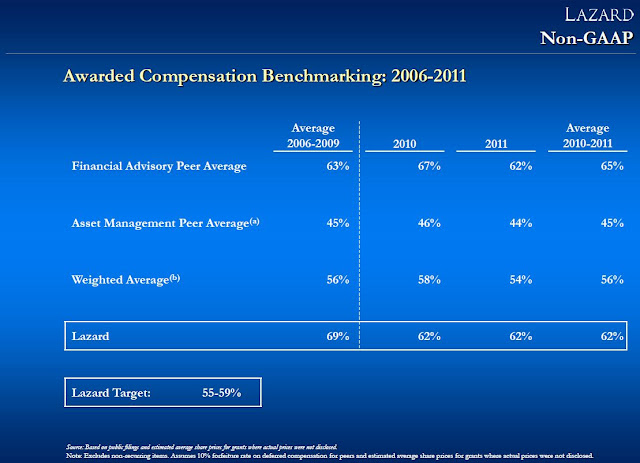
…and this shows Non-compensation expense, which looks good versus peers:
And the result is the operating margin:
Peers have averaged around 25% operating margins in 2006-2009 while LAZ’s was only 12%. They have since improved that to 18% in 2010-2011. Their goal is to get that to 25% by 2014.
No Improvement Scenario / Sanity Check
Just to do a little of our own checking, here is some historical data from the LAZ presentation:
Here is the table of earnings based on awarded compensation. To do our own scenario (versus Trian’s scenario), first let’s just make sure we got this model correct.
The above table has adjustments to it that are footnoted in the LAZ presentation.
All we want to do is to be able to manipulate the operating margin, revenues and get our own awarded EPS.
Operating revenue in 2011 was $1.9 billion and awarded operating income was $321 million. To get from the operating income of $321 million to $1.34/share in EPS, we have to deduct interest expense, taxes and then divide by diluted shares outstanding. We will use 2011 figures to see if we can get from $321 million to $1.34:
Interest expense in 2011 was $90 million and the tax rate was around 20%, and there was 137 million shares outstanding. So $321 million less $90 million is $231 million, less 20% in taxes leaves $185 million or so. With 137 million shares outstanding, that’s $1.35/share in EPS; close enough for a free blog.
Worse Case Scenario
OK, so this is not a worst case scenario. You can’t really do worst case scenarios for financials because if we have an extended recession / depression, you can’t really model that. Obviously, in that scenario, LAZ would not be a good bet.
So my downside scenario is just that the M&A business doesn’t recover and LAZ’s revenues just doesn’t grow. I do think that using the average revenues of the last three years is conservative because the financial industry is in a depressed state now, and the years 2009, 2010 and 2011 are sort of trough-like (see the long term M&A volume chart earlier in this post). We can assume that the conservative scenario is that M&A volume does NOT pick up and revenues don’t grow as Trian’s slide shows.
Using 2011 figures from the above model, I will just plug in the figures using revenues that is the average of the last three years and then various operating margin levels and all other factors the same (tax rate, interest expense and shares outstanding same as 2011):
So if the M&A business just muddles along at recent lows and LAZ earns the average revenues that it has earned in past three years, the EPS would be as shown above according to various margin levels. Since Jacobs took over and restructuring has taken place, margins has averaged 18%. If this can be sustained, even at current low revenue levels, LAZ can earn $1.40/share giving the stock a p/e ratio of 18x, or an earnings yield of 5.6%.
Clearly, this is not an attractive valuation for a steady-state, no improvement situation. If they can get their margins up to 20%-25% range, the valuation becomes much more reasonable in the 11-15x range.
For those who might have an issue with tax rates, I added pretax figures. We know that Buffett likes to pay 10x pretax and Leucadia wants to make 15% pretax returns, so those are pricing benchmarks (not that they would be interested in investing in LAZ).
On a pretax basis, even with volumes stuck at recent lows and not picking up, if they can get their margins up to 20% or so, they can still earn 8% pretax return on the current stock price; not bad at all.
Lower Interest Expense Scenario
OK, so let’s take it one step closer to Trian’s scenario. In Trian’s slide, he assumes further share repurchases (slightly lower shares outstanding) and higher revenues, but notably he has a much lower interest rate expense.
This is because the long term debt of LAZ expires in 2015 and 2017 and they yield 7%; the assumption is that they can pay down some of the debt and refinance the rest in 2014. To come up with a $46 million interest expense figure, they took the current debt at market value of $1.17 billion or so and deducted $200 million in excess capital and then applied the current trading yield levels for LAZ debt of 4.7%.
This is not at all unreasonable because it reflects debt at market and current interest rate levels for LAZ. For normalizing earnings over time, this is a fair assumption.
Also, Trian uses a 25% tax rate, so I will bump that up to 25% too.
Redoing the above spreadsheet, we get:
With this lower interest expense, LAZ looks a lot more interesting. Even with no improvment in revenues, if LAZ can maintain an 18% operating margin, LAZ is trading at 16x p/e ratio. On a pretax basis, it would be earning 8.3% on the current stock price; not bad at all given the conservative assumptions.
If margins improve, to 20-22%, then it gets reasonable pretty quickly. These independent advisors, because they are not capital intensive (and don’t have balance sheet risk) tend to trade at much higher multiples than full service investment banks and universal banks.
Here is a table of historical P/E ratios of the independent advisors; I just pulled these from Morningstar:
The averages exclude negative numbers and the 500x p/e in 2008 of LAZ. I didn’t bother with EVR since as you can see, it would be pretty meaningless.
This is not to suggest that LAZ has to trade at 20x p/e or more, but it would not be out of historical norms.
Yes, it’s a different world now. Some will argue that if you look at it that way, then banks should be worth 3-4x book value per share. Fair enough. But I do tend to think there is a better chance of advisory companies having a high multiple than banks going back to 3-4x book again (capital / leverage has been reduced etc…). These independent advisories won’t be restricted by tighter capital rules or the Volcker rule, and don’t have the balance sheet risk that is the cause of lower multiples at other financials these days.
Conclusion
So that’s just a quick look that I now admit is a neat idea. A play in the financial sector that has no balance sheet or regulatory risk, no (or minimal) conflict of interest issues. No big accidents waiting to happen.
It’s a business that is basically a services business that earns fees. Yes, it may be run by a bunch of untrustworthy, greedy bankers (not my judgement) but the new, post-Wasserstein CEO seems to be much more shareholder friendly with actual proof of that (more share repurchases, increased dividends and lower compensation expense ratio).
The M&A market, even I admit, is probably not dead and there are probably a lot of deals to come in the future for the various reasons sited in these presentations, and the market is probably at a cyclical low point following the financial crisis and the current ongoing European crisis.
This stock does have an airbag built in so if things get really hairy and bankruptcies and restructurings boom again, LAZ has a dominant position that can boost revenues to offset declines elsewhere.
Of course, this is not the cheapest stock out there, say, compared to Goldman Sachs or JPM, but it is still an interesting story nonetheless.
P.S. About Financials
I do tend to talk about financials here a lot, but I would caution that it doesn’t mean one should necessarily own a lot of financials. Financial stocks are volatile and if we have another recession, financials will get hit hard.
I talk about financials here a lot, mostly because they are unloved and hated but also because I have some comfort with them that others probably may not have. Having worked in the industry, I am probably a little more comfortable with, for example, JPM’s humongous derivatives book and other things people would run away from.
This is not to say that bad things can’t happen. There are risks in these things. If someone told me that they had 80% of their net worth in Berkshire Hathaway, I’d say, cool. That sounds fine (even though BRK did go down 50% during the crisis too).
But if someone said they had 80% of their net worth in Goldman Sachs or JP Morgan, I would say, hmmm…. you might want to think about that.
Greenblatt, in his genius book talks about concentration, but warns against being overly weighted in any single sector. Five to eight stocks may give you enough diversification to get through market volatility, but not if all five of them are financials!
Anyway, I have said this before but I just wanted to point that out. I don’t talk a lot about financials here because I think people should be heavily weighted in financial stocks; I do think they are cheap, but I post about them because I feel comfortable talking about them and feel like I have something to say about them.

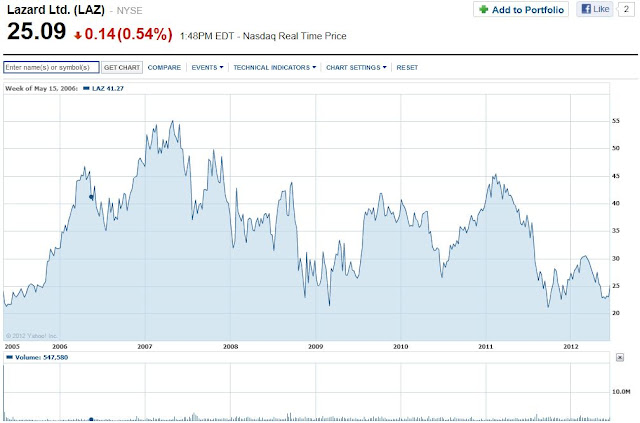

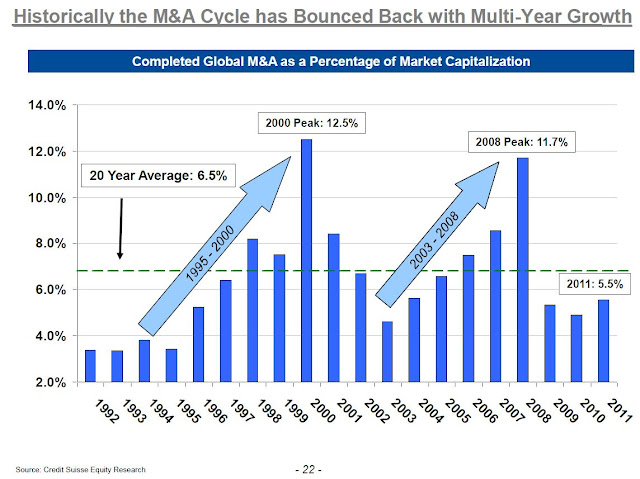
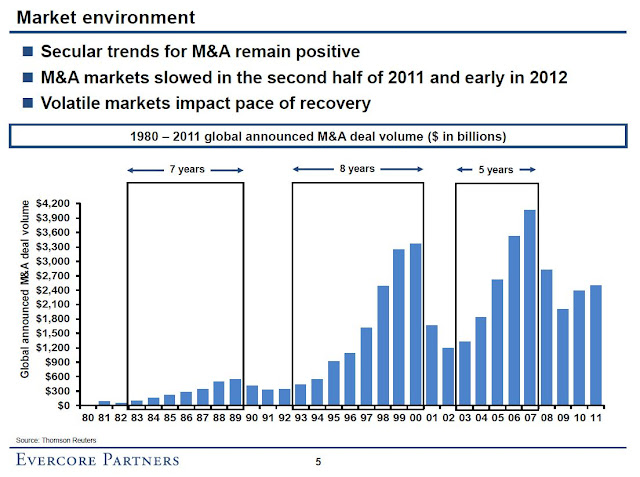
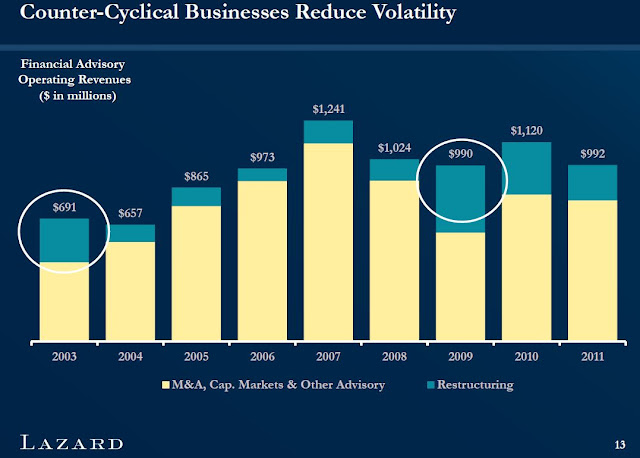
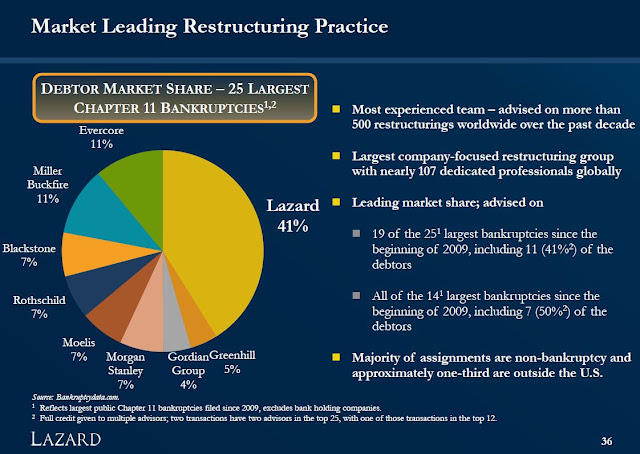
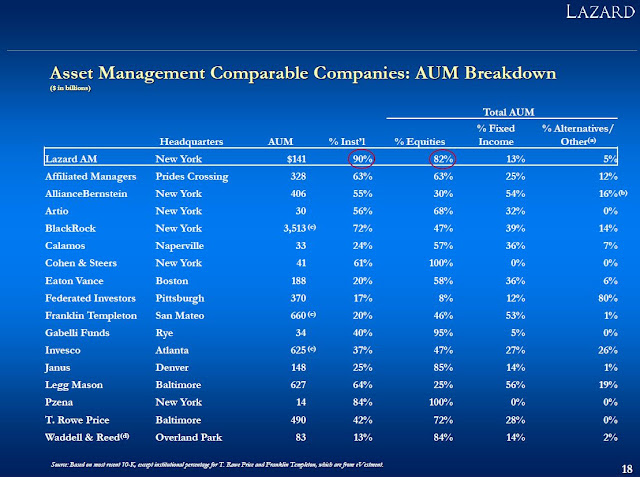
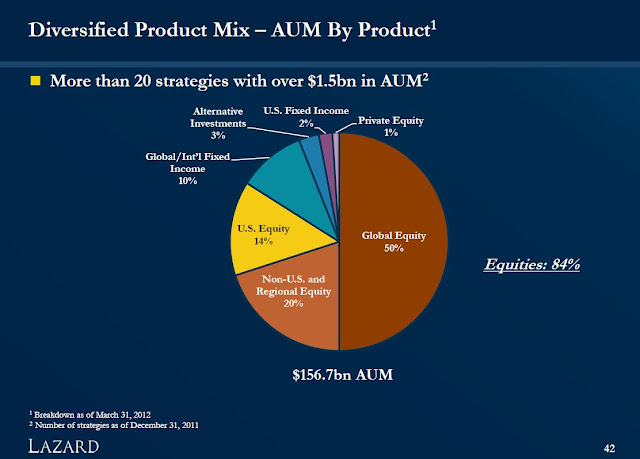
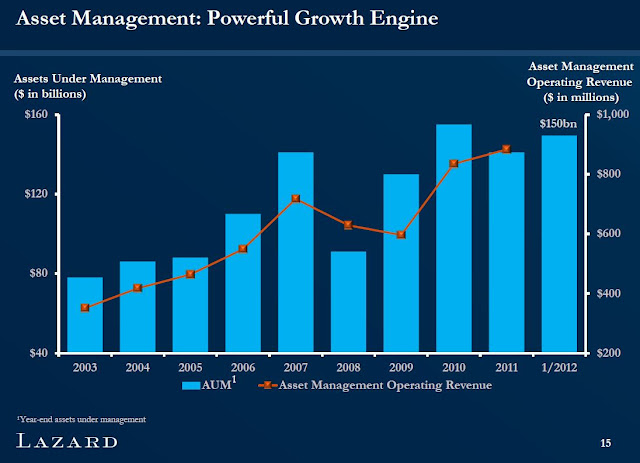
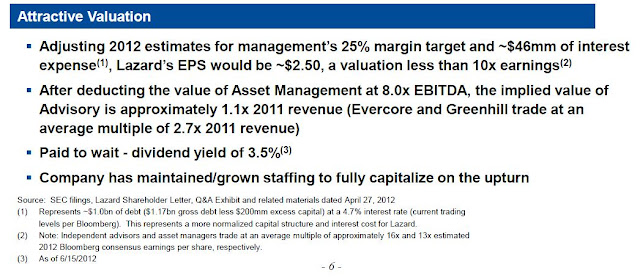
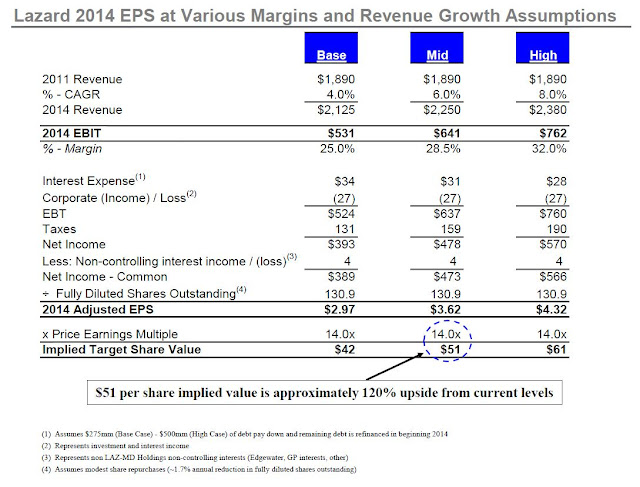
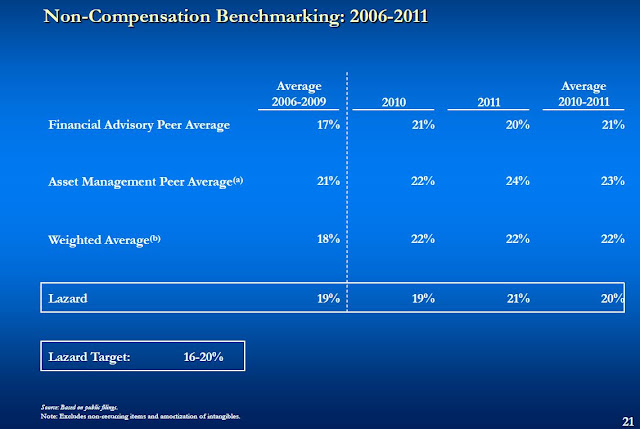
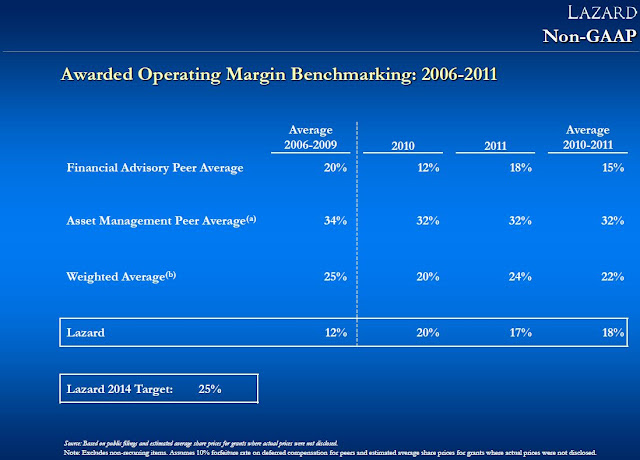
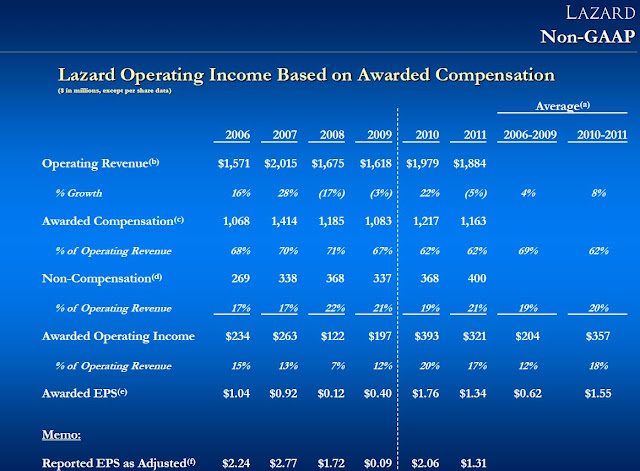
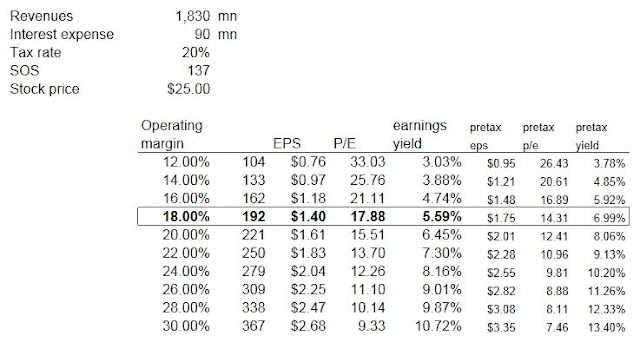
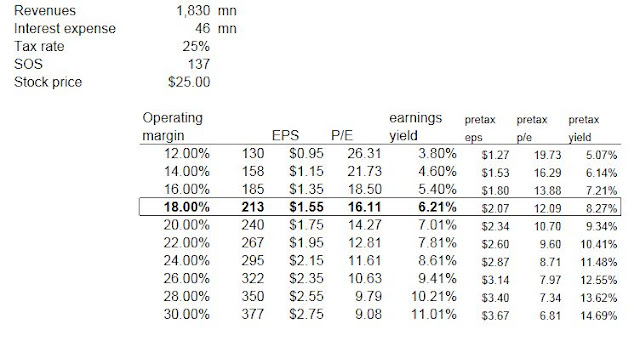

Hi Brooklyn,
Nice post- very thorough. Two questions though:
1. Do you think that getting compensation down for LAZ would be hard since their business is driven by their experienced team of rainmakers? How do you cut compensation for guys like that without potentially damaging business (if experienced guys left for example)?
2. Also, as this post was motivated by someone else's thesis, what do you think of the rule to "never trade on someone else's advice?"
http://www.wallstreetoasis.com/blog/7-indispensable-rules-for-traders
I feel like I'm learning a fair bit reading your stuff, so keep it up!
TSS
Hi,
Thanks for the post. Yes, that was my first reaction upon reading that Peltz took a stake. The assets of this company go down the elevator every single day so if you rattle the cage too much, there is a risk that they won't come back.
I think one key is that they are trying to get it in line with peers so this should be doable. Also, Peltz points out that the supply/demand equation for bankers is in favor of companies, not bankers. Also there seems to be a stream/flow of talent out of the big banks into boutiques and that is also a favorable factor.
But still, yes, that is a risk. I remember Buffett trying to get Salomon compensation sane, but it didn't work. What LAZ is trying to do isn't so drastic, I don't think. Plus it's in this kind of environment so I think people are more receptive.
As for question 2., I think it's correct to say that one should never trade on someone else's advice. This is 100% correct, and I would hate to see someone read my blog and just buy a stock.
On the other hand, one of the best sources of ideas is to see what other great investors are doing. If Buffett kicked the tires on a company and bought some, why wouldn't you look too? He has a great track record.
The difference is that you don't just go out and do what people say or blindly imitate them. You take the idea and see what you can do with it. If you research it, plug in your own numbers, think about yourself and still like it, then you can go and buy some. But at that point, you would have done enough work so it would be your idea.
Anyway, there are no bonus points for originality in investing. Of course, finding undiscovered gems is very rewarding, but getting ideas from the greats too is not a bad idea at all (as long as you do enough work on it to make it your own).
Thanks a lot; that all makes sense.
It's awesome how many guys like you make yourself resources to the community. It's a real help to college students like myself- especially from a non-target.
Wanted to post this article about M&A banker layoffs at the big banks in relation to question 1).
Should give LAZ more leverage to get that comp % down. Very interesting play on the current environment. Thanks!
http://www.bloomberg.com/news/2012-07-09/investment-bankers-face-termination-as-europe-fees-fall.html
Nice work.
I understand the M&A, Bankruptcy advisory side of this stock being a nice positive (as you said, an airbag), but I have a bit of trouble on the asset management side.
What're your thoughts on LAZ's asset management model vs. something like BLK? Do you think LAZ has baked in too much margin going forward on that side of the house?
Hi,
That's an interesting question. I think asset managers in general have a lot of operating leverage, so if AUM keeps going up and market do OK, margins should not be too hard to maintain or improve.
I can't really compare LAZ asset management to other firms as they don't provide a whole lot of detail, but I do like that it they are increasing AUM in equities versus other areas which are more bubble-like; alternative assets, bonds etc… Those are areas that seem a bit fadish to me so many alternative asset managers will probably see assets flee if equity markets do well or if alternatives go out of fashion.
BLK is a great company for sure, but a different model, I think. BLK does a lot of retail business, not to mention ETFs and others. LAZ is more an institutional business.
Anyway, sorry I can't add more color to LAZ's asset management business.
BLK is for sure a different model.
It's hard to see the trends in the retail business (product fee shrinkage, commodity products, etc.) and not think there will be some bleed over into the institutional side of the asset management business. I suppose it all boils down to the willingness of institutional investors to continue to pay for active management. If the low-growth, low-return marketplace persists for long enough, I would think institutions would have to start migrating to lower cost product.
As you said, all bets are off if the equity markets take-off again. Certainly a more contrarian asset management biz in that case.
Anyway, thanks for the reply. I've enjoyed a number of your posts; they've helped me think about quite a few of my investment ideas in a different light.
Hi I enjoy reading your stuff. Keep up the good work. Have you looked at fti consulting ticker fcn? They lack an asset mgmt biz but are big in restructuring advisory like laz. Stock has traded poorly on some bi projects rolling off and margin pressure, but as a former distressed guy I can tell you they fish in some of the same fee based ponds if you will. Just curious if you have any thoughts there, thanks.
Hi, thanks for the post and comment. No, I haven't looked at FCN but will now. I'll let you know if I find something to say about it. Thanks for the tip!
Love the blog – great thoughtful commentary.
another interesting comp in this space is OPY – under-followed (no sell-side coverage from what I can see), trading at an significant discount to book for a business that seems to be performing ok. Recent quarters are a bit messier since they have the additional costs with auction rate securities legacy issues (seems innocuous) and overlapping rents, but they expect the consolidation of office space to save them $62mm over 15 years
would love to hear your thoughts on this one!
Hi, thanks for the comment. I'm not too familiar with OPY. I see them more as a small full-service broker which I tended to think was in a tough spot (like Cowen was), but OPY seems to be doing OK. Their ROE is a little low since their Oppenheimer acquisition, but that's because they put on a bunch of goodwill/intangibles in 2003. So pricing this at book might be tough, but 0.44x book does seem cheap. Maybe it's worth tangible book. That's where I would start.
Thanks Brooklyn, fantastic work as always.
Sometimes I get a "comment" post email update but it doesn't show up here for some reason. I guess it's a blogger bug or something.
Someone posted a question about Delta Lloyd; Einhorn's idea. Delta Lloyd certainly does look cheap but I'm not too familiar with it. I think a lot of U.S. investors don't focus too much on European financials because American financials are cheap now too and there is more of a comfort level with local institutions rather than one far away.
Anyway, thanks for posting the comment.